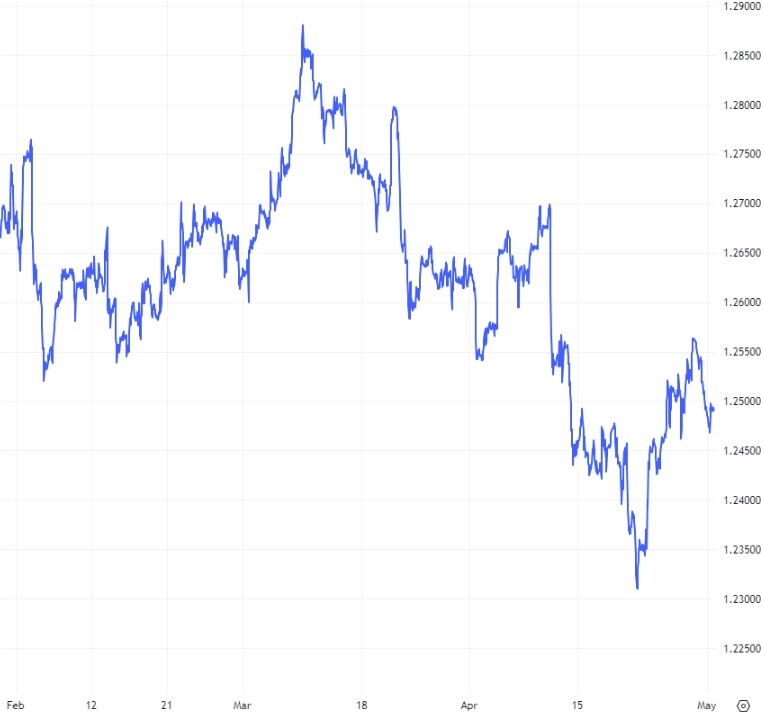GBP-USD Exchange rate rebounds from 5-month low in April
The pound, which began April just above 1.26 against the dollar, was supported by a better-than-forecast final UK manufacturing PMI print. In March, sector activity was revised upward from 49.9 to 50.3, taking it above the 50 threshold that marks growth.
Having dropped to near multi-week lows in the 1.25 mid-range, after the dollar was boosted by a surprise improvement in the ISM manufacturing PMI, the pound ticked higher following a surprise downturn in the US services sector – which posted its weakest reading in three months.
Dovish remarks from Federal Reserve Chair Jerome Powell on 3 April continued to undermine the dollar. In a speech, Powell reinforced the Fed’s current cautious approach, stating that it remained too soon to call the inflation fight over.
The pound also waned following a downward revision in March’s final services PMI reading. While the print undershot investor forecasts, it remained in growth and helps pave the way for the UK economy to exit its current recession.
The pound dollar exchange rate, which had moved back above the 1.26 benchmark, slipped lower on 5 April following the release of the latest US non-farm payrolls report, which smashed forecasts. Last month, the US private sector added a whopping 303,000 jobs compared to February, soaring past expectations of a 200,000 print.
The dollar was lifted on 10 April by warmer-than-forecast US inflation reports. Consumer prices increased more than expected in March as a third straight month of sticky inflation led financial markets to anticipate that the Fed would defer cutting interest rates until September.
Diminishing Fed interest rate cut bets along with a cautious market mood boosted the safe-haven dollar, causing the pound to slump to around 1.2435 on 11 April – a fresh five-month low.
The pound faltered following the UK’s latest GDP data, as investors continued to speculate over the overall health of the UK economy, which grew by 0.1% in February. The print divided opinion, with some analysts speculating on the seemingly ongoing economic fragility, while others were hopeful that the economy is on its way out of recession.
The UK currency languished near a five-month low on 16 April following an increase in UK unemployment. The jobless rate leapt to 4.2% in February from an upward revision of 4% the previous month. Furthermore, wage growth eased in the three months to February, with the reading down 0.1% to 6%.
Both readings stoked further bets that the Bank of England (BoE) will start loosening monetary policy in the summer.
Meanwhile, the safe-haven dollar was supported by a risk-off market mood amid ongoing tensions in the Middle East.
The pound dollar exchange rate ticked higher the following day after the UK’s latest inflation print clouded the BoE’s rate cut outlook.
The warmer-than-forecast data showed that headline inflation cooled to 3.2% in March, missing expectations of 3.1%. Despite falling for a second consecutive month and reaching its lowest level since September 2021, the sticky print was attributed to the impact of rising fuel prices.
The pound dollar rate remained muted amid forecast-beating US job data and stagnant UK retail sales, before tumbling in the wake of ramped up BoE rate cut bets. The pair touched a fresh five-month low below 1.24 as shifting interest rate cut speculations took their toll and a data lull left the pound vulnerable.
A hawkish speech from BoE Chief Economist Huw Pill on 23 April helped the pound to rebound into the 1.24 mid-range against the dollar, after stating that he believes the BoE is “some way off” cutting interest rates.
Robust UK service sector data, which grew significantly more than initially anticipated in April, created further tailwinds for the pound.
The UK currency maintained its upward momentum on 25 April, edging above 1.25 on the back of a downbeat US GDP print that dented the dollar. US economic growth fell sharply in the first quarter, with estimated GDP at 1.6%, dropping well below forecasts of a 2.5% slump, and declining from a previous reading of 3.4%.
The pound dollar exchange rate extended its gains towards the end of the month ahead of the Fed policy meeting on 1 May.
Meanwhile, the pound was supported by a risk-on mood in markets, despite a lack of significant domestic data.
GBPUSD: 3-Month Chart

Looking ahead
The BoE makes its next interest rate decision on 9 May when it’s expected to leave borrowing costs unchanged at a 15-year high of 5.25% for the sixth consecutive meeting.
Influential data from the UK economy in May: Gross Domestic Product (10 May), ILO Unemployment Rate (14 May), Consumer Price Index (22 May), S&P Global/CIPS Composite PMI (23 May), Retail Sales (24 May),
Market analysts expect interest rates to be held steady at the Fed’s next decision on 1 May. Inflation data for early 2024 has prompted concern that the transition to the central bank’s 2% inflation target may take longer than previously anticipated – pushing back rate cut expectations.
Influential data from the US economy in May: ADP Employment Change (1 May), ISM Manufacturing PMI (1 May), Nonfarm Payrolls (3 May), ISM Services PMI (3 May), Michigan Consumer Sentiment Index (10 May), Consumer Price Index (14 May), Consumer Price Index (14 May), Retail Sales (15 May), S&P Global Manufacturing PMI (23 May), S&P Global Services PMI (24 May), Gross Domestic Product Annualized (30 May), Core Personal Consumption Expenditures – Price Index (31 May).






